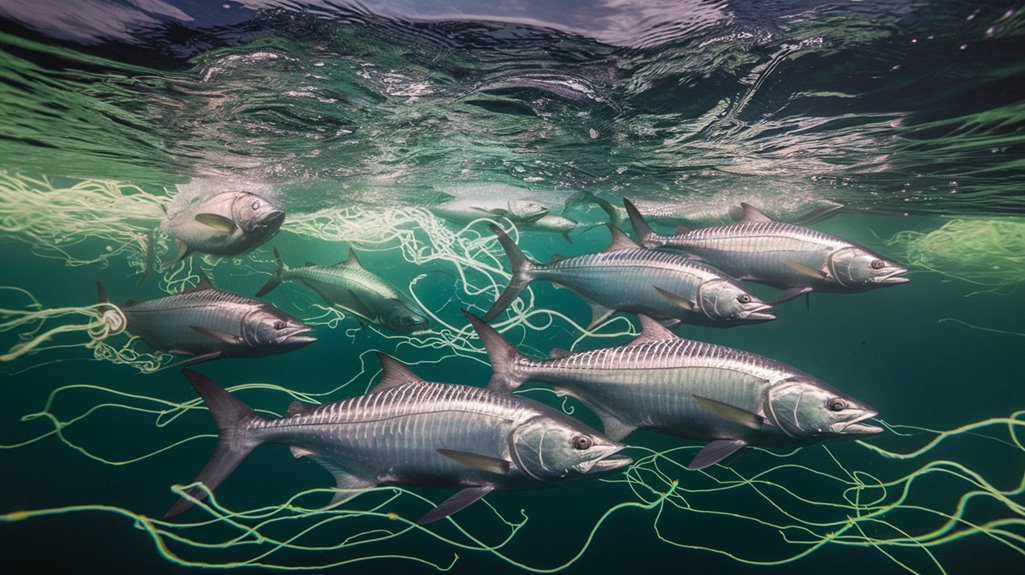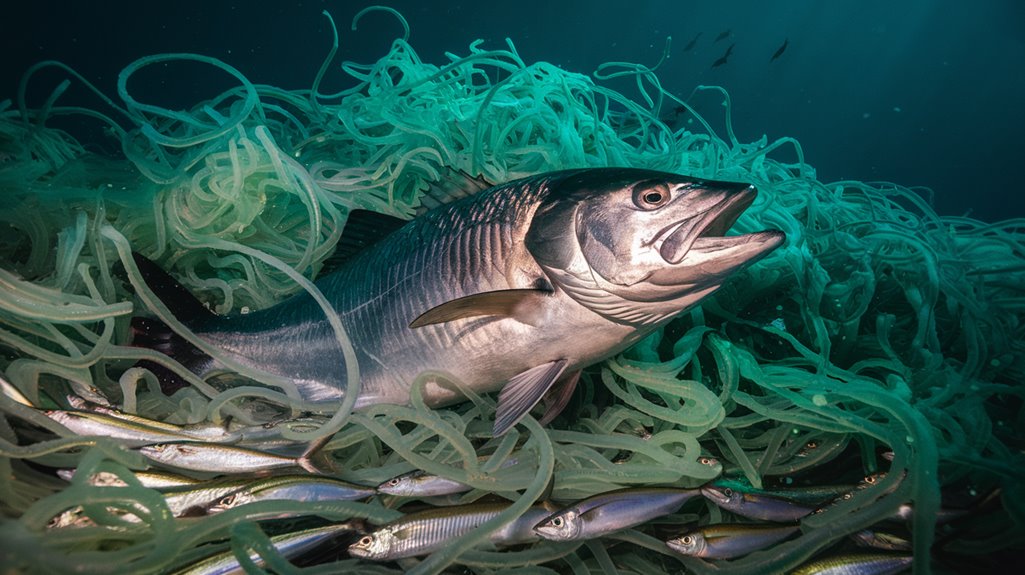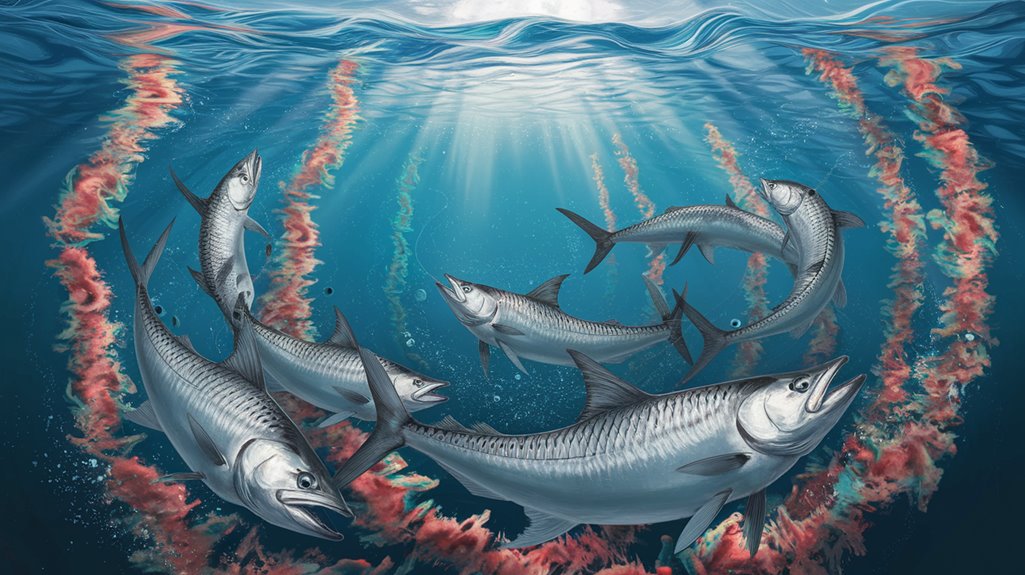If you've ever witnessed tarpon feeding during the palolo worm hatch in the Florida Keys, you'll understand why this natural phenomenon captivates marine biologists and anglers alike. These marine worms, emerging from their coral reef burrows in synchronized waves, trigger one of nature's most remarkable feeding events. The interaction between the palolo worms' reproductive cycle and the tarpon's feeding patterns reveals complex ecological relationships that continue to yield new scientific insights.
- Key Takeaways
- Understanding the Palolo Worm Phenomenon
- Unique Characteristics of Palolo Worms
- The Florida Keys Bridge Fishing Experience
- Tarpon Feeding Patterns During the Hatch
- Seasonal Impact on Fishing Strategies
- The Role of Coral Reefs in the Hatch Cycle
- Connecting With Fellow Anglers Online
- Frequently Asked Questions
- Conclusion
Key Takeaways
- Palolo worms emerge in synchronized spawning events during summer months, creating dense congregations that attract feeding tarpon.
- Tarpon shift their feeding patterns to surface waters during the hatch, actively pursuing and breaching for palolo worms.
- The hatch occurs in shallow coral reef areas of the Florida Keys, where worms release gametes aligned with lunar phases.
- Fishing success increases when anglers adapt their strategies to match the worm hatch timing and tarpon's surface feeding behavior.
- Coral reef health directly influences palolo worm populations and subsequent tarpon feeding opportunities during spawning events.
Understanding the Palolo Worm Phenomenon
During the summer months in the Florida Keys, the palolo worm phenomenon creates a remarkable display of marine biology in action. You'll find these distinctive creatures inhabiting the shallow waters near coral reefs, exhibiting a unique morphology that combines characteristics of both insects and worms. They possess small legs at their anterior end and distinctive pincher-like appendages.
The most fascinating aspect of their lifecycle occurs during their spawning event, when segments of their bodies detach and float to the surface. This mass emergence greatly impacts the local marine ecosystem, particularly affecting tarpon feeding patterns. As these worm segments become readily available at the surface, they create a concentrated food source that draws tarpon upward, temporarily altering established fishing dynamics in the Florida Keys' waters.
Unique Characteristics of Palolo Worms
You'll find palolo worms displaying distinctive characteristics, including their segmented bodies with frontal legs, pincher-like structures, and a tapered posterior region that aids their movement through coral reef habitats. These marine organisms establish themselves within the intricate cavities of reef systems, where they remain until their synchronized summer spawning events draw countless predators to the area. During their annual mass emergence, you can observe them creating dense congregations at varying depths, greatly influencing local marine ecosystems and fishing patterns.
Physical Features and Movement
Palolo worms possess distinctive anatomical features that set them apart from other marine organisms. You'll notice their unique body structure, characterized by small legs positioned exclusively on their anterior segment, while their posterior portion remains legless. At their front end, you'll find specialized teeth or pincher-like appendages that aid in feeding activities.
When observing their movement patterns, you'll see these worms emerge from their coral reef habitats during seasonal hatches. Their swimming behavior is particularly remarkable as they navigate from the reef bottom toward the surface waters. This vertical migration creates a considerable biological event that attracts predatory fish, especially tarpon. The worms' small size and vast numbers during these emergence events can greatly impact local fishing activities by altering typical fish behavior patterns.
Habitat and Distribution Patterns
While largely concentrated in tropical and subtropical waters, these marine polychaete annelids establish themselves within intricate networks of coral reef systems across the Caribbean and Pacific Oceans. You'll find them inhabiting carefully excavated burrows in sandy or muddy substrates, where they've adapted to the dynamic reef environment.
| Location | Substrate Type | Population Density |
|---|---|---|
| Coral Reefs | Sandy/Rocky | High |
| Reef Flats | Muddy | Moderate |
| Lagoons | Mixed Sediment | Variable |
Their distribution patterns correlate strongly with lunar cycles, as they emerge from their burrows during specific phases for spawning events. Water temperature markedly influences their habitat selection, with populations thriving in areas where seasonal variations maintain ideal breeding conditions. These environmental factors drive their spatial distribution across reef ecosystems.
Annual Spawning Behavior
During the summer months, these remarkable marine annelids execute one of nature's most precisely timed reproductive events. You'll observe the palolo worms releasing their gametes in synchronization with specific lunar phases, maximizing their reproductive success through this coordinated effort.
The worms' segmented bodies undergo a fascinating transformation as specialized segments break away and float to the surface. These segments, equipped with pincher-like structures on their heads, release reproductive materials into the water column. This process triggers a cascading effect in the marine ecosystem, as the spawning event attracts numerous predatory fish, particularly tarpon, creating a dynamic feeding opportunity.
The timing of this reproductive display isn't just essential for the worms' survival; it's also critical for maintaining the Florida Keys' marine food web.
The Florida Keys Bridge Fishing Experience
You'll find ideal bridge fishing access points throughout the Florida Keys during the palolo worm hatch by arriving early to secure parking spots near bridge entrances and pedestrian walkways. The most productive fishing occurs during the early morning or late evening hours when tarpon actively feed on these organisms, particularly during summer months from May through August. Your equipment should include medium-heavy spinning gear, circle hooks sized 5/0 to 7/0, and fresh bait options that mimic the appearance of palolo worms, such as soft plastic lures in similar colors and sizes.
Bridge Location Accessibility Tips
As seasoned anglers prepare for the palolo worm hatch, strategic access to Florida Keys bridges becomes essential for ideal fishing success. You'll need to optimize your bridge location strategy by evaluating timing and accessibility factors that maximize your chances of a successful catch.
Critical location access points to evaluate:
- Select bridges with adequate parking facilities and safe entry points, particularly during peak morning and late afternoon periods
- Position yourself at locations that offer unobstructed casting zones, accounting for potential crowding during the hatch
- Identify bridges that align with local regulations and provide sufficient space for gear setup
When selecting your fishing position, factor in the bridge's orientation relative to tidal flows and common tarpon feeding patterns. This systematic approach to bridge selection will greatly enhance your fishing productivity during the palolo worm hatch season.
Best Times To Fish
While palolo worms emerge throughout the day, successful bridge fishing in the Florida Keys hinges on targeting specific time windows that enhance your catch potential. You'll find peak fishing conditions during summer months when palolo worms are most abundant, drawing tarpon to the surface in concentrated numbers.
Focus your efforts during early morning or late evening periods when cooler temperatures prompt increased tarpon feeding activity. Monitor tidal movements carefully, as these influence palolo worm emergence patterns and subsequent tarpon behavior. When you observe tarpon breaking the surface to feed on worms, you've identified a prime fishing window. Position yourself strategically on the bridge during these moments, particularly when tidal flows are strongest, to intercept tarpon as they target the rising worms.
Equipment and Bait Selection
Making the most of palolo worm hatches requires precise equipment selection and specialized bait strategies. Light tackle proves essential when targeting tarpon from bridge positions, allowing for better control during their aggressive feeding periods. Your arsenal should include both natural and artificial options to adapt to changing conditions.
Key equipment priorities:
- Light-action rods paired with appropriate reels for maximum sensitivity
- Selection of artificial lures including topwater plugs and soft plastics
- Landing net sized appropriately for tarpon
Incorporate live bait options such as pilchards or pinfish alongside the naturally occurring palolo worms. This dual approach maximizes your chances when tarpon alternate between feeding zones. Monitor the depth distribution of palolo worms and adjust your presentation accordingly, as this biological phenomenon greatly influences tarpon behavior patterns.
Tarpon Feeding Patterns During the Hatch
The palolo worm hatch triggers a dramatic shift in tarpon feeding behavior throughout the Florida Keys. You'll observe these typically deep-water fish moving to surface waters, where they aggressively pursue the abundant worms. During this phenomenon, you'll notice tarpon breaching the water's surface as they compete for this seasonal food source.
The feeding patterns become more concentrated and competitive as multiple tarpon converge on worm-rich areas. You'll find that the varying emergence depths of palolo worms directly influence the tarpon's feeding success rates. This surface-oriented feeding activity can impact your traditional deep-water fishing strategies, as the fish abandon their usual patterns to capitalize on this ephemeral food source. Understanding these behavioral changes is essential for adapting your fishing techniques during the summer hatch period.
Seasonal Impact on Fishing Strategies

During summer months in the Florida Keys, successful fishing strategies must adapt to accommodate the dramatic influence of palolo worm hatches. You'll need to understand the complex relationship between these marine organisms and your target species, particularly tarpon, which actively feed on these worms during their emergence.
To optimize your fishing success during the palolo hatch, consider these critical factors:
- Monitor water column depths where palolo worms concentrate
- Adjust your bait presentation to compete with natural worm patterns
- Track seasonal timing of hatches to anticipate peak feeding periods
Your traditional fishing techniques may become less effective as tarpon shift their feeding behavior to focus on the abundant worm population. Understanding the palolo lifecycle and its impact on marine ecosystems will greatly enhance your ability to adapt and maintain productive fishing results.
The Role of Coral Reefs in the Hatch Cycle
Beneath the surface of tropical waters, intricate coral reef ecosystems provide essential breeding grounds and habitat structures for palolo worms throughout their developmental stages. You'll find that these reefs serve as vital nurseries where the worms mature until they're ready for their synchronized spawning events during specific lunar phases.
The reef's health directly influences the worm population's success rate and reproductive timing. When you're studying these marine environments, you'll notice how water temperature and clarity variations, which depend on reef conditions, affect the depth at which worms emerge. If you're monitoring the ecosystem's health, you'll observe that any coral degradation can disrupt the delicate balance, impacting not only the palolo worms but also the predatory species like tarpon that rely on this cyclic feast for sustenance.
Connecting With Fellow Anglers Online

While exploring the fascinating world of palolo worm hatches, you'll find invaluable resources through online fishing communities that specialize in seasonal phenomena. Platforms like "kidscanfish" and "girlscanfish" on Facebook serve as central hubs for anglers to exchange technical knowledge and real-time updates about marine life events.
To maximize your engagement with these digital communities, focus on:
- Monitoring seasonal fishing patterns and tarpon behavior during summer months
- Participating in discussions about adaptive fishing techniques during the palolo worm hatch
- Analyzing successful strategies shared by experienced anglers
You'll discover that these online platforms facilitate extensive knowledge exchange about local marine conditions, allowing you to refine your approach based on collective experiences and documented fishing patterns during specific biological events.
Frequently Asked Questions
Are Palolo Worms Safe to Eat?
You can safely consume palolo worms when they're properly harvested from clean waters and cooked thoroughly. They're protein-rich, but you'll want to test for allergies if you're sensitive to shellfish.
What Does Palolo Worm Taste Like?
You'll experience palolo worms' unique briny-sweet oceanic flavor profile when eaten raw, while cooking transforms them to taste more like seafood with shrimp-like notes and a delicate, soft texture.
What Are the Benefits of Palolo Worm?
You'd think tiny worms aren't worth much, but palolo worms provide crucial ecosystem services, enhance marine biodiversity, serve as essential fish bait, and contain protein-rich nutrients beneficial to their consumers.
Where Do Palolo Worms Come From?
You'll find palolo worms inhabiting coral reef systems in tropical waters, particularly in the Pacific Ocean. They burrow into the reef's substrate, creating extensive networks within the limestone structure.
Conclusion
You'll find that timing your fishing excursion with the palolo worm emergence maximizes your probability of intercepting mature megalops atlanticus during their feeding aggregations. By analyzing lunar phases and monitoring water temperatures, you can predict these reproductive events with increasing accuracy. The symbiotic relationship between substrate-dwelling annelids and their piscine predators presents an ideal opportunity for technical bridge-based angling success in the Florida Keys ecosystem.

